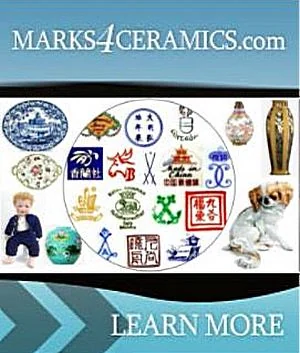Pricing Guides & Dictionary of Makers Marks for Antiques & Collectibles

A few examples of appraisal values for
FOSSIL SKULL
Search our price guide for your own treasures
-
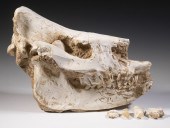 FOSSILIZED SKULL Slightly
FOSSILIZED SKULL Slightly compressed, with internal remnants of the sandstone matrix, having marks of professional excavation, the loose teeth retaining some enamel. 23" x 15" x 8 1/2".
FOSSILIZED SKULL Slightly
FOSSILIZED SKULL Slightly compressed, with internal remnants of the sandstone matrix, having marks of professional excavation, the loose teeth retaining some enamel. 23" x 15" x 8 1/2". -
 GROUP OF FOSSILS, SKULLS, TEETH,
GROUP OF FOSSILS, SKULLS, TEETH, & MINERALS .
GROUP OF FOSSILS, SKULLS, TEETH,
GROUP OF FOSSILS, SKULLS, TEETH, & MINERALS . -
 A FOSSILIZED BISON SKULLA
A FOSSILIZED BISON SKULLA fossilized bison skull, Circa 1st century BCE or later; North America A well-preserved fossilized skull of an American bison, also mistakenly known as an American buffalo Dimensions: 27" H x 28" W x 8" D
A FOSSILIZED BISON SKULLA
A FOSSILIZED BISON SKULLA fossilized bison skull, Circa 1st century BCE or later; North America A well-preserved fossilized skull of an American bison, also mistakenly known as an American buffalo Dimensions: 27" H x 28" W x 8" D -
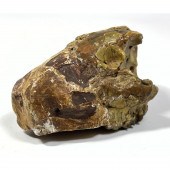 Fossilized oreodont skull Partial
Fossilized oreodont skull Partial Fossilized Jaw with Row of Teeth. Dimensions: H: 3 inches: W: 5 inches: D: 3 inches --- Condition: Ancient. There is plaster reconstruction of the partial front skull.
Fossilized oreodont skull Partial
Fossilized oreodont skull Partial Fossilized Jaw with Row of Teeth. Dimensions: H: 3 inches: W: 5 inches: D: 3 inches --- Condition: Ancient. There is plaster reconstruction of the partial front skull. -
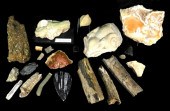 FOSSILS AND OTHER GEOLOGICAL
FOSSILS AND OTHER GEOLOGICAL FORMATIONS, 20+ PIECES, ITEMS OF INTEREST INCLUDE: SKULL OF A SHEEP-LIKE ANIMAL, AGED APPROXIMATELY 20...Fossils and other geological formations, 20+ pieces, items of interest include: skull of a sheep-like animal, aged approximately 20 million years old, on base, 9" l.; geode slices, polished stones, fossilized bone, petrified wood, etc., all pieces with wear consistent with age and use, sold as is.
FOSSILS AND OTHER GEOLOGICAL
FOSSILS AND OTHER GEOLOGICAL FORMATIONS, 20+ PIECES, ITEMS OF INTEREST INCLUDE: SKULL OF A SHEEP-LIKE ANIMAL, AGED APPROXIMATELY 20...Fossils and other geological formations, 20+ pieces, items of interest include: skull of a sheep-like animal, aged approximately 20 million years old, on base, 9" l.; geode slices, polished stones, fossilized bone, petrified wood, etc., all pieces with wear consistent with age and use, sold as is. -
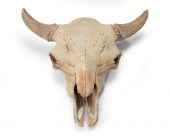 A FOSSILIZED BISON SKULLA
A FOSSILIZED BISON SKULLA fossilized bison skull, Circa 21st-1st century BCE or later; North America A well-preserved fossilized skull of an American bison, also mistakenly known as an American buffalo 20" H x 24" W" x 9" D Notes: The bison is an undisputed icon of the American West with a wide, heavy face, prominent eye sockets, and curved horns that project horizontally. A member of the bovine family, the bison diverged from a common ancestor with the water buffalo and African buffalo around 5 to 10 million years ago. During the late Middle Pleistocene, around 195,000-135,000 years ago, the bison migrated across the Bering land bridge from Eurasia into North America, eventually becoming the American bison we know today. Dimensions: 20" H x 24" W" x 9" D
A FOSSILIZED BISON SKULLA
A FOSSILIZED BISON SKULLA fossilized bison skull, Circa 21st-1st century BCE or later; North America A well-preserved fossilized skull of an American bison, also mistakenly known as an American buffalo 20" H x 24" W" x 9" D Notes: The bison is an undisputed icon of the American West with a wide, heavy face, prominent eye sockets, and curved horns that project horizontally. A member of the bovine family, the bison diverged from a common ancestor with the water buffalo and African buffalo around 5 to 10 million years ago. During the late Middle Pleistocene, around 195,000-135,000 years ago, the bison migrated across the Bering land bridge from Eurasia into North America, eventually becoming the American bison we know today. Dimensions: 20" H x 24" W" x 9" D -
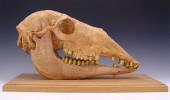 CAST FOSSIL CAMEL HYANICANIUS
CAST FOSSIL CAMEL HYANICANIUS SKULL: 1 of 4 cast for by the Natural History Museum of Gainesville, one of which is displayed on fully mounted specimen. Mounted on wooden base. Skull measures 9'' high x 16'' x 6''. From the Steven Jacobsen Collection.
CAST FOSSIL CAMEL HYANICANIUS
CAST FOSSIL CAMEL HYANICANIUS SKULL: 1 of 4 cast for by the Natural History Museum of Gainesville, one of which is displayed on fully mounted specimen. Mounted on wooden base. Skull measures 9'' high x 16'' x 6''. From the Steven Jacobsen Collection. -
 FOSSILIZED MAMMOTH TUSKThe lower
FOSSILIZED MAMMOTH TUSKThe lower part carved with a face. Height 15.5 in.
FOSSILIZED MAMMOTH TUSKThe lower
FOSSILIZED MAMMOTH TUSKThe lower part carved with a face. Height 15.5 in. -
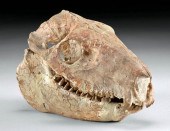 FOSSILIZED OREODONT MERYCOIDODON
FOSSILIZED OREODONT MERYCOIDODON CULBERTSONI SKULLNorth America, Western United States, South Dakota, Scenic, Upper Brule Formation, Oligocene, ca. 28.1 million to 23 million years ago. A fossilized upper cranium and lower mandible from a prehistoric oreodont with most of the teeth intact! A bar has been added to the jawbone for mounting on a stand to create an open mouth pose, but currently the upper fits comfortably on the lower in a resting position. The teeth are an interesting high crown shape; pointy and triangular, and their name translates to "mountain tooth" and these mammals were herbivores, roaming the prehistoric North America grasslands in herds grinding up the plants with their "mountainous" teeth. Size (upper): 7" L x 4.75" W x 2.75" H (17.8 cm x 12.1 cm x 7 cm) Provenance: private New Jersey, USA collection All items legal to buy/sell under U.S. Statute covering cultural patrimony Code 2600, CHAPTER 14, and are guaranteed to be as described or your money back. A Certificate of Authenticity will accompany all winning bids. PLEASE NOTE: Due to recent increases of shipments being seized by Australian & German customs (even for items with pre-UNESCO provenance), we will no longer ship most antiquities and ancient Chinese art to Australia & Germany. For categories of items that are acceptable to ship to Australia or Germany, please contact us directly or work with your local customs brokerage firm. Display stands not described as included/custom in the item description are for photography purposes only and will not be included with the item upon shipping. #172128 Condition: Professionally prepared and restored. Restoration and infill to gaps and fissures, repairs to tooth crowns, with some chips and losses. Loss to orbit bone left side. Wooden bar added to mandible for support on stand.
FOSSILIZED OREODONT MERYCOIDODON
FOSSILIZED OREODONT MERYCOIDODON CULBERTSONI SKULLNorth America, Western United States, South Dakota, Scenic, Upper Brule Formation, Oligocene, ca. 28.1 million to 23 million years ago. A fossilized upper cranium and lower mandible from a prehistoric oreodont with most of the teeth intact! A bar has been added to the jawbone for mounting on a stand to create an open mouth pose, but currently the upper fits comfortably on the lower in a resting position. The teeth are an interesting high crown shape; pointy and triangular, and their name translates to "mountain tooth" and these mammals were herbivores, roaming the prehistoric North America grasslands in herds grinding up the plants with their "mountainous" teeth. Size (upper): 7" L x 4.75" W x 2.75" H (17.8 cm x 12.1 cm x 7 cm) Provenance: private New Jersey, USA collection All items legal to buy/sell under U.S. Statute covering cultural patrimony Code 2600, CHAPTER 14, and are guaranteed to be as described or your money back. A Certificate of Authenticity will accompany all winning bids. PLEASE NOTE: Due to recent increases of shipments being seized by Australian & German customs (even for items with pre-UNESCO provenance), we will no longer ship most antiquities and ancient Chinese art to Australia & Germany. For categories of items that are acceptable to ship to Australia or Germany, please contact us directly or work with your local customs brokerage firm. Display stands not described as included/custom in the item description are for photography purposes only and will not be included with the item upon shipping. #172128 Condition: Professionally prepared and restored. Restoration and infill to gaps and fissures, repairs to tooth crowns, with some chips and losses. Loss to orbit bone left side. Wooden bar added to mandible for support on stand. -
 LARGE GROUP OF FOSSILS .
LARGE GROUP OF FOSSILS .
LARGE GROUP OF FOSSILS .
LARGE GROUP OF FOSSILS . -
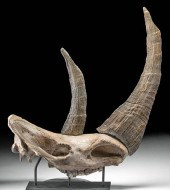 FOSSILIZED SIBERIAN WOOLLY
FOSSILIZED SIBERIAN WOOLLY RHINOCEROS SKULLCentral Asia, Siberia, Pleistocene, ca. 2.58 million to 12,000 years ago. A rare and striking skull from one of the most famous beasts of the last Ice Age - the Woolly Rhinoceros (Coelodonta antiquitatis). Now extinct, the head of the ancient beast presents a lengthy, rounded snout, a pair of sizable nostrils, huge, sunken eyes, and twelve teeth, each showing a thick enamel and the swirling structure of the internal cavity. The enormous animal could grow to 12.5 feet (3.8 meters) in length and 4,400 pounds (2,000 kilograms) and featured two giant horns with the longer reaching forwards and the smaller between the eyes, as well as a long fur coat with a thick undercoat. A powerful hump on the creature's back allowed it to support its heavy horns. Size: 30" L x 13" W x 36" H (76.2 cm x 33 cm x 91.4 cm); 39.5" H (100.3 cm) on included custom stand. Regardless of their massive bodies and brutish appearance, woolly rhinoceros primarily fed upon grasses and sedges in the mammoth steppe, hence their downward facing heads, flat teeth, and lack of incisors. This fact is lucky for the paleolithic humans who not only lived beside them, but also drew representations of the ancient rhinos on cave walls in France and built statuettes of beasts in the Czech republic. Interestingly, however, when a fossilized head of the animal was first recovered in 1335 in Austria, it was believed to belong to a dragon, and later in 1590, it became classified as an "ancient griffin". By the 18th and 19th century, researchers began to recognize the animal as part of the rhinoceros family, yet having the fur of a woolly mammoth, part of the elephant family. So, what did they call this fascinating cross between an elephant and a rhino? Elephino! Provenance: ex-Dinosaur Brokers, Woodland Park, Colorado, USA All items legal to buy/sell under U.S. Statute covering cultural patrimony Code 2600, CHAPTER 14, and are guaranteed to be as described or your money back. A Certificate of Authenticity will accompany all winning bids. PLEASE NOTE: Due to recent increases of shipments being seized by Australian & German customs (even for items with pre-UNESCO provenance), we will no longer ship most antiquities and ancient Chinese art to Australia & Germany. For categories of items that are acceptable to ship to Australia or Germany, please contact us directly or work with your local customs brokerage firm. Display stands not described as included/custom in the item description are for photography purposes only and will not be included with the item upon shipping. #163210 Condition: Missing lower jaw and horns are modern replacements. Vertical drill hole to top of nose and top of skull for the horns. Repaired from several pieces with break lines visible in some areas and restoration over break lines in others. Overall restoration limited to 10 to 15%. Otherwise, excellent with lustrous surface.
FOSSILIZED SIBERIAN WOOLLY
FOSSILIZED SIBERIAN WOOLLY RHINOCEROS SKULLCentral Asia, Siberia, Pleistocene, ca. 2.58 million to 12,000 years ago. A rare and striking skull from one of the most famous beasts of the last Ice Age - the Woolly Rhinoceros (Coelodonta antiquitatis). Now extinct, the head of the ancient beast presents a lengthy, rounded snout, a pair of sizable nostrils, huge, sunken eyes, and twelve teeth, each showing a thick enamel and the swirling structure of the internal cavity. The enormous animal could grow to 12.5 feet (3.8 meters) in length and 4,400 pounds (2,000 kilograms) and featured two giant horns with the longer reaching forwards and the smaller between the eyes, as well as a long fur coat with a thick undercoat. A powerful hump on the creature's back allowed it to support its heavy horns. Size: 30" L x 13" W x 36" H (76.2 cm x 33 cm x 91.4 cm); 39.5" H (100.3 cm) on included custom stand. Regardless of their massive bodies and brutish appearance, woolly rhinoceros primarily fed upon grasses and sedges in the mammoth steppe, hence their downward facing heads, flat teeth, and lack of incisors. This fact is lucky for the paleolithic humans who not only lived beside them, but also drew representations of the ancient rhinos on cave walls in France and built statuettes of beasts in the Czech republic. Interestingly, however, when a fossilized head of the animal was first recovered in 1335 in Austria, it was believed to belong to a dragon, and later in 1590, it became classified as an "ancient griffin". By the 18th and 19th century, researchers began to recognize the animal as part of the rhinoceros family, yet having the fur of a woolly mammoth, part of the elephant family. So, what did they call this fascinating cross between an elephant and a rhino? Elephino! Provenance: ex-Dinosaur Brokers, Woodland Park, Colorado, USA All items legal to buy/sell under U.S. Statute covering cultural patrimony Code 2600, CHAPTER 14, and are guaranteed to be as described or your money back. A Certificate of Authenticity will accompany all winning bids. PLEASE NOTE: Due to recent increases of shipments being seized by Australian & German customs (even for items with pre-UNESCO provenance), we will no longer ship most antiquities and ancient Chinese art to Australia & Germany. For categories of items that are acceptable to ship to Australia or Germany, please contact us directly or work with your local customs brokerage firm. Display stands not described as included/custom in the item description are for photography purposes only and will not be included with the item upon shipping. #163210 Condition: Missing lower jaw and horns are modern replacements. Vertical drill hole to top of nose and top of skull for the horns. Repaired from several pieces with break lines visible in some areas and restoration over break lines in others. Overall restoration limited to 10 to 15%. Otherwise, excellent with lustrous surface. -
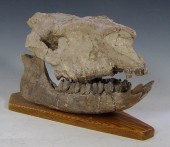 RUNNING RHINOCEROS HYRACODON
RUNNING RHINOCEROS HYRACODON SKULL FOSSIL: Upper & lower, all teeth intact, 2 are erupting. 100% complete. Found near Chadron, Nebraska. On wood stand. Approx. 9'' x 17'' x 9'' on stand. Found by and from the Steven Jacobson collection.CONDITION: As with all fossils, there may be areas of repair or lines where the fossil was assembled. This particular skull is very fragile.
RUNNING RHINOCEROS HYRACODON
RUNNING RHINOCEROS HYRACODON SKULL FOSSIL: Upper & lower, all teeth intact, 2 are erupting. 100% complete. Found near Chadron, Nebraska. On wood stand. Approx. 9'' x 17'' x 9'' on stand. Found by and from the Steven Jacobson collection.CONDITION: As with all fossils, there may be areas of repair or lines where the fossil was assembled. This particular skull is very fragile. -
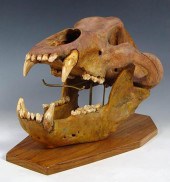 LARGE MALE EUROPEAN CAVE BEAR SKULL
LARGE MALE EUROPEAN CAVE BEAR SKULL FOSSIL: Complete upper & lower, all teeth, approx. 80% original. On wood stand. Found near Brasov, Romania. Approx. 12'' h x 20'' x 12'' on stand. From the Steven Jacobson Collection. Purchased at the Phillips Natural History auction, December 1995.CONDITION: As with all fossils, there may be areas of repair or lines where the fossil was assembled.
LARGE MALE EUROPEAN CAVE BEAR SKULL
LARGE MALE EUROPEAN CAVE BEAR SKULL FOSSIL: Complete upper & lower, all teeth, approx. 80% original. On wood stand. Found near Brasov, Romania. Approx. 12'' h x 20'' x 12'' on stand. From the Steven Jacobson Collection. Purchased at the Phillips Natural History auction, December 1995.CONDITION: As with all fossils, there may be areas of repair or lines where the fossil was assembled. -
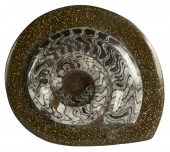 FOSSIL SPECIMEN7 1/2 x 8 inches
FOSSIL SPECIMEN7 1/2 x 8 inches Condition:
FOSSIL SPECIMEN7 1/2 x 8 inches
FOSSIL SPECIMEN7 1/2 x 8 inches Condition: -
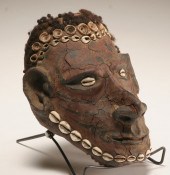 Oceanic over-molded skull, Papua
Oceanic over-molded skull, Papua New Guinea; Middle Sepik River style clay application on animal skull. Face accented with cowrie shells, dyed scarification, and real hair. Provenance: from the estate of Harrison Eiteljorg. 9 1/2"H. x 7 1/2"W. Good condition, dry clay surface.
Oceanic over-molded skull, Papua
Oceanic over-molded skull, Papua New Guinea; Middle Sepik River style clay application on animal skull. Face accented with cowrie shells, dyed scarification, and real hair. Provenance: from the estate of Harrison Eiteljorg. 9 1/2"H. x 7 1/2"W. Good condition, dry clay surface. -
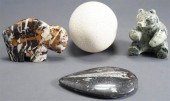 FOSSILIZED SPECIMEN, TWO CARVED
FOSSILIZED SPECIMEN, TWO CARVED STONE ANIMAL FIGURINES AND AN OSTRICH EGGFossilized Specimen, Two Carved Stone Animal Figurines and an Ostrich Egg
FOSSILIZED SPECIMEN, TWO CARVED
FOSSILIZED SPECIMEN, TWO CARVED STONE ANIMAL FIGURINES AND AN OSTRICH EGGFossilized Specimen, Two Carved Stone Animal Figurines and an Ostrich Egg -
 Fossilized fish skeleton 14 in.
Fossilized fish skeleton 14 in. L. 6 in. W. Estimate $ 200-300 Age appropriate cracks in rock appropriate wear.
Fossilized fish skeleton 14 in.
Fossilized fish skeleton 14 in. L. 6 in. W. Estimate $ 200-300 Age appropriate cracks in rock appropriate wear. -
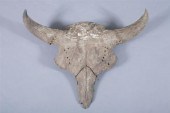 BISON SKULL. Wisconsin excavation
BISON SKULL. Wisconsin excavation
BISON SKULL. Wisconsin excavation
BISON SKULL. Wisconsin excavation -
 PLEISTOCENE CAVE BEAR
PLEISTOCENE CAVE BEAR SKULLweathered bone surfaces, full set of teeth, fixed mandible, 8-3/4 in x 17 in x 9 in longest teeth 2 in. Provenance: Private Collection Condition: mostly original skull with possible repairs, surface weathering, fissures, and losses from the peripheries and zygomatic arch as expected with fossilization
PLEISTOCENE CAVE BEAR
PLEISTOCENE CAVE BEAR SKULLweathered bone surfaces, full set of teeth, fixed mandible, 8-3/4 in x 17 in x 9 in longest teeth 2 in. Provenance: Private Collection Condition: mostly original skull with possible repairs, surface weathering, fissures, and losses from the peripheries and zygomatic arch as expected with fossilization -
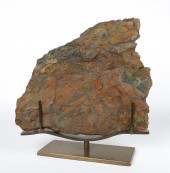 A Large fossil slab on stand,
A Large fossil slab on stand, red-brown shale slab, fossilized fern material, on fitted brushed brass stand, 18 1/2"L x 15"H, 18 3/4"H in stand
A Large fossil slab on stand,
A Large fossil slab on stand, red-brown shale slab, fossilized fern material, on fitted brushed brass stand, 18 1/2"L x 15"H, 18 3/4"H in stand -
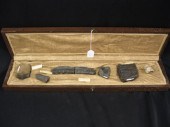 Collection of Fossils includes
Collection of Fossils includes Mammouth & more in display box.
Collection of Fossils includes
Collection of Fossils includes Mammouth & more in display box. -
 FOSSIL FISH ON LIMESTONE NODULE
FOSSIL FISH ON LIMESTONE NODULE HALF BRAZILFossil Fish on Limestone Nodule Half , Brazilian Fossil Fish, Racocepis buccalis agassiz, Santana Formation of Serra de Armripe Mountains, Ceara Province, Lower Creraceous, Brazil. Over 60 Million years old. 11" x 6" x 1.5" From the Estate of Frank Hall owner of Dover Scientific and collector of rocks, crystals, minerals and fossils.
FOSSIL FISH ON LIMESTONE NODULE
FOSSIL FISH ON LIMESTONE NODULE HALF BRAZILFossil Fish on Limestone Nodule Half , Brazilian Fossil Fish, Racocepis buccalis agassiz, Santana Formation of Serra de Armripe Mountains, Ceara Province, Lower Creraceous, Brazil. Over 60 Million years old. 11" x 6" x 1.5" From the Estate of Frank Hall owner of Dover Scientific and collector of rocks, crystals, minerals and fossils. -
 FOSSILIZED THREE TOED HORSE UPPER
FOSSILIZED THREE TOED HORSE UPPER SKULL & TEETHNorth America, Western United States, South Dakota, Pennington, Brule Formation, Oligocene, ca. 33 to 30 million years ago. A fossilized upper skull from a prehistoric equine known as the three-toed horse, Mesohippus bairdi- the translation means "middle horse" due to its place on the timeline of horse evolution! These animals were petite in comparison to their modern relatives - this upper is easily picked up in one hand, but the shift towards equines of today is quite pronounced in the teeth- here the well-preserved premolars can be viewed from the side, their teeth squarer than predecessors to grind grasses and leaves, but they still retain some primitive triangularity from pulverizing fruits and berries. This fossil rests on a flat base, as a perfect display piece and cornerstone specimen of horse evolution and early development. Size: 9" L x 4" W x 3" H (22.9 cm x 10.2 cm x 7.6 cm) Provenance: private New Jersey, USA collection All items legal to buy/sell under U.S. Statute covering cultural patrimony Code 2600, CHAPTER 14, and are guaranteed to be as described or your money back. A Certificate of Authenticity will accompany all winning bids. PLEASE NOTE: Due to recent increases of shipments being seized by Australian & German customs (even for items with pre-UNESCO provenance), we will no longer ship most antiquities and ancient Chinese art to Australia & Germany. For categories of items that are acceptable to ship to Australia or Germany, please contact us directly or work with your local customs brokerage firm. Display stands not described as included/custom in the item description are for photography purposes only and will not be included with the item upon shipping. #172125 Condition: Professionally prepared and areas of restoration: nasal bone process, front incisor teeth and bone, zygomatic arch, and frontal bone. Clear fixative coating to bones. Upper skull only with great preservation to premolars / molars.
FOSSILIZED THREE TOED HORSE UPPER
FOSSILIZED THREE TOED HORSE UPPER SKULL & TEETHNorth America, Western United States, South Dakota, Pennington, Brule Formation, Oligocene, ca. 33 to 30 million years ago. A fossilized upper skull from a prehistoric equine known as the three-toed horse, Mesohippus bairdi- the translation means "middle horse" due to its place on the timeline of horse evolution! These animals were petite in comparison to their modern relatives - this upper is easily picked up in one hand, but the shift towards equines of today is quite pronounced in the teeth- here the well-preserved premolars can be viewed from the side, their teeth squarer than predecessors to grind grasses and leaves, but they still retain some primitive triangularity from pulverizing fruits and berries. This fossil rests on a flat base, as a perfect display piece and cornerstone specimen of horse evolution and early development. Size: 9" L x 4" W x 3" H (22.9 cm x 10.2 cm x 7.6 cm) Provenance: private New Jersey, USA collection All items legal to buy/sell under U.S. Statute covering cultural patrimony Code 2600, CHAPTER 14, and are guaranteed to be as described or your money back. A Certificate of Authenticity will accompany all winning bids. PLEASE NOTE: Due to recent increases of shipments being seized by Australian & German customs (even for items with pre-UNESCO provenance), we will no longer ship most antiquities and ancient Chinese art to Australia & Germany. For categories of items that are acceptable to ship to Australia or Germany, please contact us directly or work with your local customs brokerage firm. Display stands not described as included/custom in the item description are for photography purposes only and will not be included with the item upon shipping. #172125 Condition: Professionally prepared and areas of restoration: nasal bone process, front incisor teeth and bone, zygomatic arch, and frontal bone. Clear fixative coating to bones. Upper skull only with great preservation to premolars / molars. -
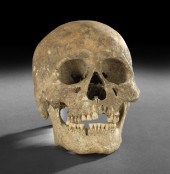 Human Skull, of unknown origin,
Human Skull, of unknown origin, the mandible detached but present, retaining many teeth, h. 6", w. 5-1/2", circ. 19-1/2".
Human Skull, of unknown origin,
Human Skull, of unknown origin, the mandible detached but present, retaining many teeth, h. 6", w. 5-1/2", circ. 19-1/2". -
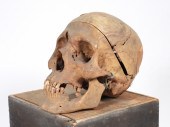 HUMAN SCIENTIFIC STUDY MEDICAL
HUMAN SCIENTIFIC STUDY MEDICAL SKULL ,19th CenturyWood box holding skull medical skull with head cap removed for internal study.
HUMAN SCIENTIFIC STUDY MEDICAL
HUMAN SCIENTIFIC STUDY MEDICAL SKULL ,19th CenturyWood box holding skull medical skull with head cap removed for internal study. -
 Two Fossilized Ammonite Specimens,
Two Fossilized Ammonite Specimens, each the mineralized shell of the extinct animal, exhibiting varied patterns of fossilization and opaque and transparent colors in shades of brown, ochre, white and rose, l. 7-1/4" and 7-1/2".
Two Fossilized Ammonite Specimens,
Two Fossilized Ammonite Specimens, each the mineralized shell of the extinct animal, exhibiting varied patterns of fossilization and opaque and transparent colors in shades of brown, ochre, white and rose, l. 7-1/4" and 7-1/2". -
 FOSSILIZED MOSASAUR SKULL - RARE
FOSSILIZED MOSASAUR SKULL - RARE TETHYSAURUS NOPCSAINorth Africa, Morocco, Errachidia Province, Goulmima, Upper Cretaceous, ca. 93.9 to 89.8 million years ago. This is a rare example of a prehistoric mosasaur species known as Tethysaurus nopcsai, the only species from the Tethysaurus family! As the mosasaur fossilized, some of the bones shifted and separated- part of the mandible or palatal teeth are between the upper and lower jaws, but the overall form of the snout and eye orbit well preserved, and the white stone matrix contrasts well against the umber brown hues of bone and teeth. Tethysaurus was a transitional species between more primitive mosasaurs and later species. The large teeth and hinged jaws enabled mosasaurs to gulp down their prey nearly whole, like modern day snakes. This carnivorous lizard possessed a streamlined body, flattened tail, and webbed feet and somewhat resembled flippered crocodiles. Size: 10.75" L x 1.5" W x 5" H (27.3 cm x 3.8 cm x 12.7 cm) Provenance: private New Jersey, USA collection, purchased from Geocartera in 2016 All items legal to buy/sell under U.S. Statute covering cultural patrimony Code 2600, CHAPTER 14, and are guaranteed to be as described or your money back. A Certificate of Authenticity will accompany all winning bids. PLEASE NOTE: Due to recent increases of shipments being seized by Australian & German customs (even for items with pre-UNESCO provenance), we will no longer ship most antiquities and ancient Chinese art to Australia & Germany. For categories of items that are acceptable to ship to Australia or Germany, please contact us directly or work with your local customs brokerage firm. Display stands not described as included/custom in the item description are for photography purposes only and will not be included with the item upon shipping. #172123 Condition: Partial skull as shown. Repaired with visible break lines and infill to gaps. Great preservation to teeth. Old inventory numbers on surface.
FOSSILIZED MOSASAUR SKULL - RARE
FOSSILIZED MOSASAUR SKULL - RARE TETHYSAURUS NOPCSAINorth Africa, Morocco, Errachidia Province, Goulmima, Upper Cretaceous, ca. 93.9 to 89.8 million years ago. This is a rare example of a prehistoric mosasaur species known as Tethysaurus nopcsai, the only species from the Tethysaurus family! As the mosasaur fossilized, some of the bones shifted and separated- part of the mandible or palatal teeth are between the upper and lower jaws, but the overall form of the snout and eye orbit well preserved, and the white stone matrix contrasts well against the umber brown hues of bone and teeth. Tethysaurus was a transitional species between more primitive mosasaurs and later species. The large teeth and hinged jaws enabled mosasaurs to gulp down their prey nearly whole, like modern day snakes. This carnivorous lizard possessed a streamlined body, flattened tail, and webbed feet and somewhat resembled flippered crocodiles. Size: 10.75" L x 1.5" W x 5" H (27.3 cm x 3.8 cm x 12.7 cm) Provenance: private New Jersey, USA collection, purchased from Geocartera in 2016 All items legal to buy/sell under U.S. Statute covering cultural patrimony Code 2600, CHAPTER 14, and are guaranteed to be as described or your money back. A Certificate of Authenticity will accompany all winning bids. PLEASE NOTE: Due to recent increases of shipments being seized by Australian & German customs (even for items with pre-UNESCO provenance), we will no longer ship most antiquities and ancient Chinese art to Australia & Germany. For categories of items that are acceptable to ship to Australia or Germany, please contact us directly or work with your local customs brokerage firm. Display stands not described as included/custom in the item description are for photography purposes only and will not be included with the item upon shipping. #172123 Condition: Partial skull as shown. Repaired with visible break lines and infill to gaps. Great preservation to teeth. Old inventory numbers on surface. -
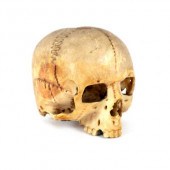 An ivory skull, probably English or
An ivory skull, probably English or German, 19th Century, 5cm high/see illustration
An ivory skull, probably English or
An ivory skull, probably English or German, 19th Century, 5cm high/see illustration -
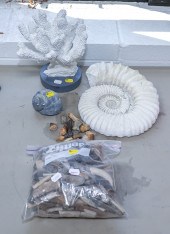 GROUP OF FOSSILIZED BONES Primarily
GROUP OF FOSSILIZED BONES Primarily Miocene marine animals, including teeth and claws. Together with decorative coral and ammonite casts.
GROUP OF FOSSILIZED BONES Primarily
GROUP OF FOSSILIZED BONES Primarily Miocene marine animals, including teeth and claws. Together with decorative coral and ammonite casts. -
 Rocks Lot. Fossilized bone.
Rocks Lot. Fossilized bone. Dimensions: H: 4 inches: W: 7 inches: D: 5 inches --- Condition: Wear.
Rocks Lot. Fossilized bone.
Rocks Lot. Fossilized bone. Dimensions: H: 4 inches: W: 7 inches: D: 5 inches --- Condition: Wear. -
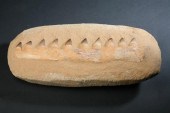 MOSASAUR PARTIAL JAW BONE FOSSIL
MOSASAUR PARTIAL JAW BONE FOSSIL Cretaceous Period; Morocco. With ten teeth; in a sandstone matrix - 14 1/4 in. long jaw only.
MOSASAUR PARTIAL JAW BONE FOSSIL
MOSASAUR PARTIAL JAW BONE FOSSIL Cretaceous Period; Morocco. With ten teeth; in a sandstone matrix - 14 1/4 in. long jaw only. -
 LARGE SECTION OF FOSSILIZED IVORY
LARGE SECTION OF FOSSILIZED IVORY TUSK from a pre-historic mastodon a large tusked mammal species from the extinct genus Mammut. Length 34'' circumference at center 13''.
LARGE SECTION OF FOSSILIZED IVORY
LARGE SECTION OF FOSSILIZED IVORY TUSK from a pre-historic mastodon a large tusked mammal species from the extinct genus Mammut. Length 34'' circumference at center 13''. -
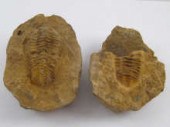 A trilobite fossil in two parts.
A trilobite fossil in two parts.
A trilobite fossil in two parts.
A trilobite fossil in two parts. -
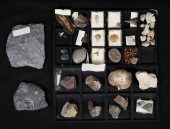 FOSSIL FERN NAUTILUS DINOSAUR
FOSSIL FERN NAUTILUS DINOSAUR BONE TRILOBITEFossil fern on shale St. Clair, Pennsylvania. Fossil Nautilus (Eutrephoceras dekayi) Cheyenne River, South Dakota. Vertebrata (Stegosaurus ungulatus). Trilobita Amphixina. Dinosaur gizzard stone (Gastrolith). Acorn barnacles Caloosahatchee Formation De Soto County, Florida. From the Estate of Frank Hall owner of Dover Scientific and collector of rocks, crystals, minerals and fossils.
FOSSIL FERN NAUTILUS DINOSAUR
FOSSIL FERN NAUTILUS DINOSAUR BONE TRILOBITEFossil fern on shale St. Clair, Pennsylvania. Fossil Nautilus (Eutrephoceras dekayi) Cheyenne River, South Dakota. Vertebrata (Stegosaurus ungulatus). Trilobita Amphixina. Dinosaur gizzard stone (Gastrolith). Acorn barnacles Caloosahatchee Formation De Soto County, Florida. From the Estate of Frank Hall owner of Dover Scientific and collector of rocks, crystals, minerals and fossils. -
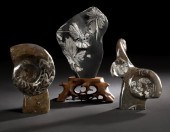 Sculptural Ammonite Fossil
Sculptural Ammonite Fossil Specimen, 100 million years old, composed of a large polished ammonite fossil in brown, gray and white with crystalline inclusions atop a brown variegated matrix base, h. 10-1/2".
Sculptural Ammonite Fossil
Sculptural Ammonite Fossil Specimen, 100 million years old, composed of a large polished ammonite fossil in brown, gray and white with crystalline inclusions atop a brown variegated matrix base, h. 10-1/2". -
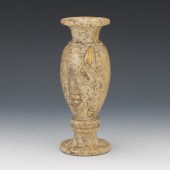 PREHISTORIC FOSSIL SLUB CARVED VASE
PREHISTORIC FOSSIL SLUB CARVED VASE 8" Baluster form carved and polished prehistoric fossil vase. Containing the impression of prehistoric organisms in petrified form.
PREHISTORIC FOSSIL SLUB CARVED VASE
PREHISTORIC FOSSIL SLUB CARVED VASE 8" Baluster form carved and polished prehistoric fossil vase. Containing the impression of prehistoric organisms in petrified form.
...many more examples with full details are available to our members - Learn more
